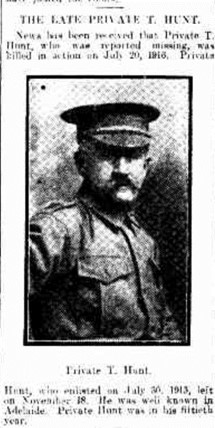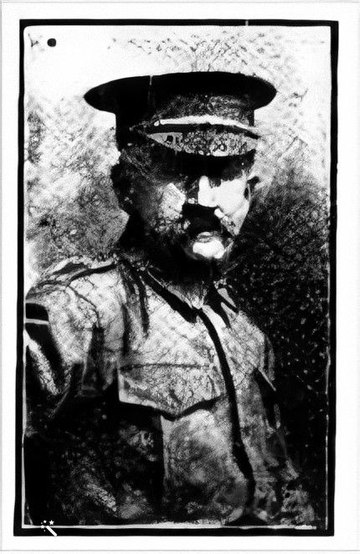
Thomas HUNT
Eyes brown, Hair grey, Complexion fresh
Thomas Hunt – Never too old to do your part
Can you help us identify Thomas?
Thomas Hunt was killed in Action at Fromelles. As part of the 32nd Battalion he was positioned near where the Germans collected soldiers who were later buried at Pheasant Wood. There is a chance he might be identified, but we need help. We are still searching for suitable family DNA donors.
In 2008 a mass grave was found at Fromelles, a grave the Germans dug for 250 (Australian) bodies they recovered after the battle.
If you know anything of Thomas’ contacts here in Australia please contact the Fromelles Association.
See the DNA box at the end of the story for what we do know about his family.
Thomas Hunt was not your ‘typical’ enlistee, a young man or a teenager (who might lie that they were older than they were) off seeking adventure. At 49, Thomas was too old to join, so when he enlisted he took five years off of his actual age in order to be accepted. Thomas was born at Meriwa Station, between Goondiwindi and Warialda in 1866.
He was the fourth of Thomas and Mary Hunt’s (nee Carney)’s six children – two girls and four boys. In about 1884-85, when Thomas would have been 18 years old, a contingent from New South Wales was raised to support Britain in a war in Sudan and he signed up and served with this unit for three years, but did not see action. Thomas was a blacksmith by trade and travelled throughout the country looking for work.
He was known to enjoy a drink and newspaper articles cite a few incidents that got him into trouble. His wanderings took him south and in 1896 he married Isabella McDougall Brown in Melbourne. After living in Victoria for a year, he and Isabella moved to the Riverina district of New South Wales.
They had three children, but sadly all died at relatively young ages:
- Annie Isabella McDougall – 1897-1902
- Arthur 1898-1898
- Thomas “Tom” Wallace 1900-1916, who likely died from diabetes related illnesses
The marriage seemed to have been a difficult one. While he was an itinerant blacksmith, he did send money to Isabella regularly. He had returned to Victoria to live and asked Isabella to join him, but she refused. She later sent a letter that intimated she would not live with him again. In 1908 Thomas moved to South Australia. He and Isabella met there and he again asked her to stay with him, but she did not - she went to Sydney. The last time he saw her was in 1912. In July 1915, he filed for divorce. Source 1915 'IN THE COURTS.', The Register (Adelaide, SA : 1901 - 1929), 7 July, p. 11. , http://nla.gov.au/nla.news-article59412384
With some years of being separated from Isabella and living in Adelaide, Thomas had met Caroline Winter. They planned to marry as soon as the law allowed following Thomas’ divorce, but he left Australia for the War before this could happen. They had a daughter, Gladys, born in 1916 after Thomas left.
Off to War
With the ramp up of support for the War, Thomas signed up again to do his part for Great Britain on 29 July 1915. While he was 49, he stated on his enlistment papers that he was 44 so that he could be accepted. He was assigned to the newly formed 32nd Battalion, A Company. The battalion was made up of two companies from South Australia and two from Western Australia. Training for the South Australians was at the Mitcham Camp.
The men from WA arrived in Adelaide at the end of August. The 32nd embarked from Adelaide, South Australia on 18 November 1915 aboard HMAT A2 Geelong, headed for Egypt. They were ‘properly’ farewelled:
“The 32nd Battalion went away with the determination to uphold the newborn prestige of Australian troops, and they were accorded a farewell which reflected the assurance of South Australians that that resolve would be realized.”
After arriving in Suez on 14 December 1915 they went to the El Ferdan camp. A month later they marched to Ismailia , then to the large camp at Tel el Kebir for February and most of March. During their time in Egypt the 32nd did have had the honour of being inspected by H.R.H. Prince of Wales and they greeted him with “enthusiastic cheers”.
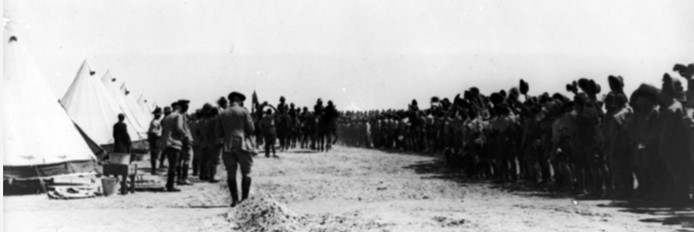
Egyptian conditions did wear on the soldiers. One soldier’s diary complained of being ‘sick up to the neck of heat and flies’, of the scarcity of water during their long marches through the sand and he described some of the food as ‘dog biscuits and bully beef’, but he did go on to mention good times as well with swims, mail from home, visiting the local sights and the like.
Source AWM C2081789 Diary of Theodor Milton PFLAUM 1915-16, page 29, page 12 You can read Theodor’s Soldier Story here
To the Western Front
After spending six months in Egypt, the call to support the British Expeditionary Force on the Western Front came in mid-June. They left from Alexandria aboard the ship Transylvania on 17th June 1916 and arrived at Marseilles, France on 23rd June 1916. After arriving in Marseilles, the 32nd departed by train for the two-day trip to Steenbecque. Their route took them to a station just out of Paris, within sight of the Eiffel Tower, then through Bologne and Calais, with a view of the Channel before marching to their camp at Morbecque, about 30 kilometres from Fleurbaix.
Theodor Pflaum (No. 327) wrote about the trip in his diary:
“The people flocked out all along the line and cheered us as though we had the Kaiser as prisoner on board!!”
Training continued with a focus on bayonets and the use of gas masks, assuredly with a greater emphasis given their position near the Front.
The Battle of Fromelles
The 32nd moved to the Front on 14 July and were into the trenches for the first time on 16 July, only three weeks after arriving in France.
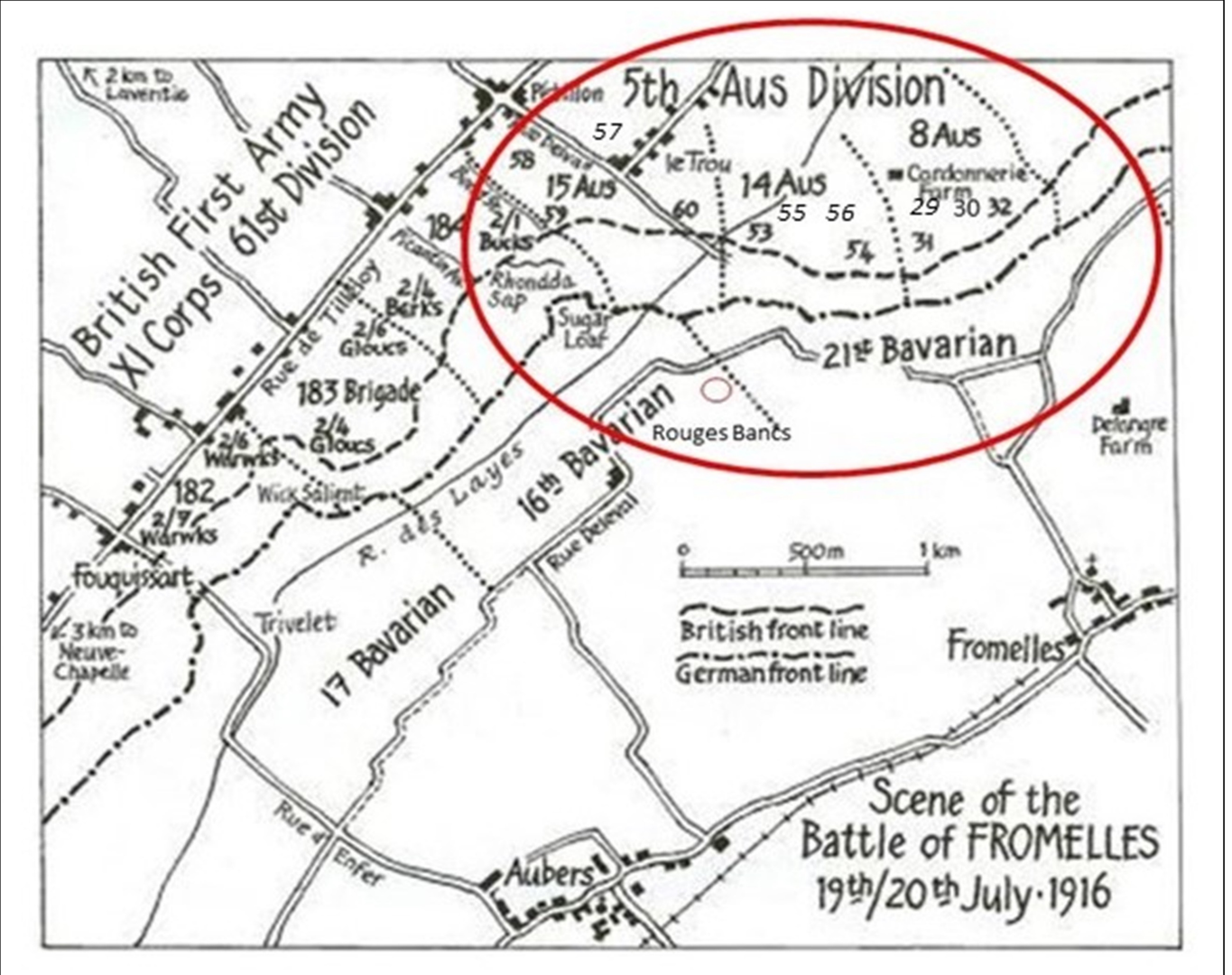
On the 17th they were reconnoitering the trenches and cutting passages through the wires, preparing for an attack, but it was delayed due to the weather.
D Company’s Lieutenant Sam Mills’ letters home were optimistic for the coming battle:
“We are not doing much work now, just enough to keep us fit—mostly route marching and helmet drill. We have our gas helmets and steel helmets, so we are prepared for anything. They are both very good, so a man is pretty safe.”
On the morning of the 18th, A and C Companies went back into the trenches and were then joined by B and D Companies on the 19th, ready for battle. All were in position by 5.45 PM and the charge over the parapet began at 5.53 PM. Thomas’s A Company and C Company were the first and second waves to go, B & D the third and fourth. They were successful in their initial assaults and by 6.30 PM were in control of the German’s 1st line system (map Trench B), which was described as ‘practically a ditch with from 1 to 2 feet of mud and slush at the bottom’.
Source AWM4 23/49/12, 32nd Battalion War Diaries, July 1916, page 11
Unfortunately, with the success of their attack, ‘friendly’ artillery fire caused a large number of casualties. They were able to take out a German machine gun in their early advances, but they were being ‘seriously enfiladed’ from their left flank.
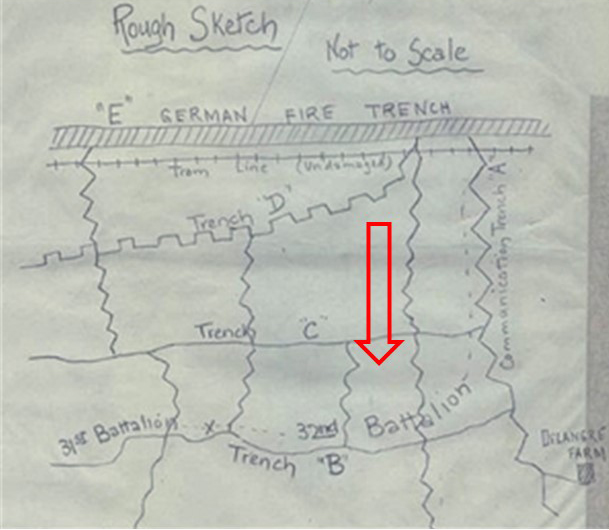
By 8.30 PM their left flank had come under heavy bombardment with high explosives and shrapnel. Return bombardment support was provided and the 32nd was told that ‘the trenches were to be held at all costs’.
Source AWM4 23/49/12, 32nd Battalion War Diaries, July 1916, page 12
Fighting continued through the night. Up ahead, the Australians made a further charge at the main German line beyond Trench B, but they were low on grenades, there was machine gun fire from behind and from the emplacement at Delangre Farm and they were so far advanced that they were getting shelled by both sides. At 4.00 AM the Germans began an attack from the Australian’s left flank, bombing and advancing into Trench A (map). Given the Australian advances that had been made earlier, the rear Trench E had been left almost empty, which then enabled the Germans to be in a position to surround the soldiers of the 32nd.
At 5.30 AM the Germans attacked from both flanks in force with bombing parties. Having only a few grenades left, the only resistance the 31st could offer was with rifles:
“The enemy swarmed in and the retirement across No Mans’ Land resembled shambles, the enemy artillery and machine guns doing deadly damage.”
What was left of the 32nd had finally withdrawn by 7.30 AM on the 20th. The initial head count was devastating – 71 killed, 375 wounded and 219 missing. To get some perspective of the battle, when Charles Bean, Australia’s official war historian, attended the battlefield two and half years later, he observed a large amount of bones, torn uniforms and Australian kit still on the battlefield.
The final impact was that 225 soldiers of the 32nd Battalion were killed or died from wounds sustained at the battle and of this 166 were unidentified. As of 2024, 41 of these soldiers have been identified from the German mass grave at Pheasant Wood found in 2008.
Lieutenant Sam Mills survived the battle. In his letters home, he recalls the bravery of the men:
“They came over the parapet like racehorses……… However, a man could ask nothing better, if he had to go, than to go in a charge like that, and they certainly did their job like heroes."
Thomas’ fate
Exactly what happened to Thomas during the battle is uncertain, but he was listed on a 4 November 1916 German ‘death list’, so the Germans had recovered his body and ID disc. This would have put him in the advance area of the battle when he was killed.
The father of one of Thomas’ fellow soldiers, Harold Jose (121), came across a 7 September 1916 article from the Adelaide newspapers that attributed a heroic action to ‘Hunt’ and ‘Jose’ and he wrote the Army about the ‘remarkable coincidence’, asking them to follow up on it.
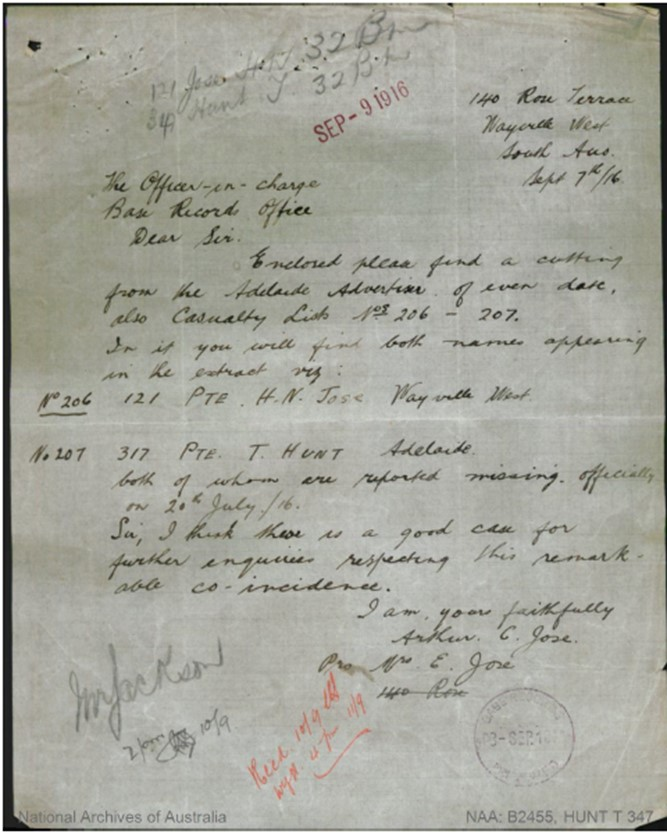
“An Australian officer describes the following gallant episode which occurred in the region of Mouquet Farm: -
The Australians, who had advanced for several hundred yards were ordered to dig in. A screen of scouts were sent forward, including a lad named Jose.
He had not gone 50 yards when German snipers picked him off. Private Hunt immediately went to the assistance of Jose. Hunt was wounded while he was dressing Jose's wounds, but he continued to do so, and then picked him up and carried him towards the Australian trench.
He was again wounded, and stumbled, but he once more picked up the boy. When they were only ten yards from safety a cowardly sniper fired a bullet which passed through the hearts of both Jose and Hunt. The Australians brought in the bodies and buried them together.”
Unfortunately, the Army replied to Harold’s father that their enquiries could not find any information relating the article for either Thomas or Harold. In line with ‘remarkable coincidences’, there were ALSO two soldiers named Hunt (George -3138) and Jose (William - 3146) in the 8th Battalion. Both were killed on 17 August 1916 in Pozieres (near to Mouquet Farm), during working parties which had gone forward and were under rifle fire, so this is a likely basis for the 7th September 1916 newspaper article.
Given the chaos of the War and with timely and accurate information being at a premium, it is easy to see how there could have been confusion between the two pairs of soldiers. All four of the families would have been impacted by the unusual uncertainties related to this article in the newspaper. It is likely that it was never resolved. All four soldiers have never been identified.
There are no records of Thomas’ burial. Thomas was awarded the 1914-15 Star Medal, the Victory Medal, the British War Medal, a Memorial Scroll and a Memorial Plaque. He is commemorated at:
- V.C. Corner (Panel No 5), Australian Cemetery Memorial, Fromelles, France,
- the Australian War Memorial Roll of Honour
- and the Adelaide National War Memorial.
Who was entitled to Thomas’ medals?
Thomas had divorced Isabella in 1915 and they had no surviving children. He did not get a chance to marry Caroline Winter before he left and they did have a child, Gladys. Who does the Army give Thomas’ medals to? Not a straightforward question. As his last legal relation, the Army first contacted Isabella asking if she would like Thomas’ medals or if they could be given to his daughter Gladys. Isabella requested that she (Isabella) be given the medals.
Then they wrote Caroline/Gladys asking if she objected to the medals being given to Isabella. Caroline strongly objected to Isabella receiving any of the medals (below). This situation was not a new issue for the Army, so they proposed to split the medal distribution – the Star and Victory Medals and Memorial Scroll to Gladys and the British War Medal and Memorial Plaque to Isabella.
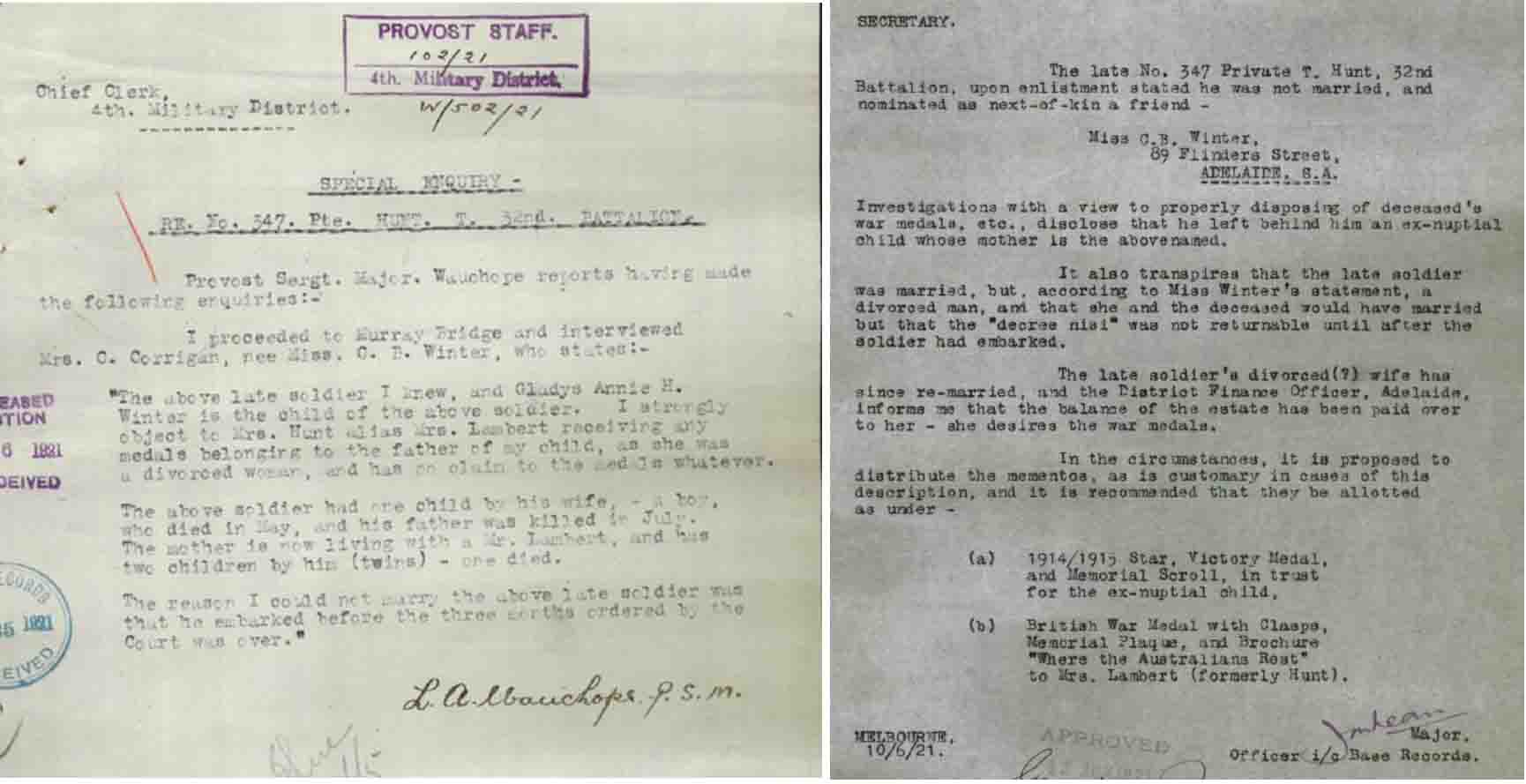
Can Thomas still be found?
In 2008, a mass grave that had been dug by the Germans was discovered. It contained 250 bodies. One of the remaining unidentified bodies from the grave could be Thomas. We need family DNA donors to find out.
The other Thomas Hunt
Thomas wasn’t the only ‘older’ Thomas Hunt to be killed in action at Fromelles. Thomas Vincent Hunt (1054), a 47 year old, originally from Victoria was part of the 31st Battalion, A Company. He was also identified on the German Death Lists and remains in an unknown grave. You can read his story here.
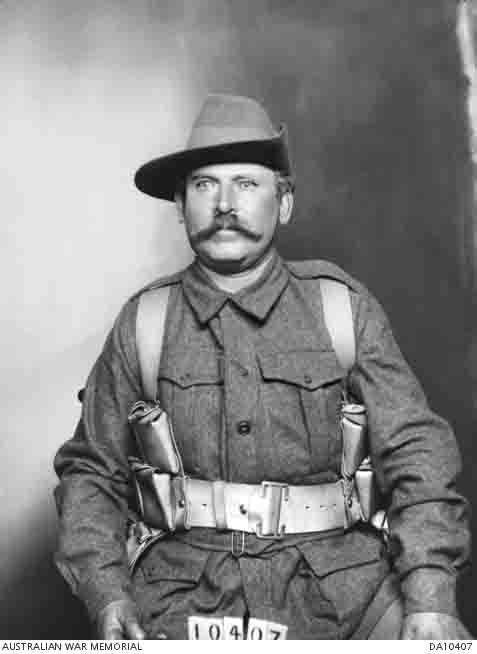
DNA samples are being sought for family connections to
| Soldier | Thomas Hunt 1829-1916, Goondiwindi, Queensland) |
| Parents | |||
| Thomas Hunt 1829-1880 B Singleton, NSW d Walcha, NSW and Mary Carney 1831-1918 B Bathurst, NSW D Parramatta, NSW |
| Siblings | |||
| Mary Hunt 1860-1930 | |||
| Lavinia Hunt 1862-1886 | |||
| James Hunt 1865-1865 | |||
| Patrick Joseph Hunt 1868-1949 | |||
| Hugh Aloysius (Alton) Hunt 1871-1915 |
| Grandparents | |||
| Paternal | John Hunt 1797-1883 and Catherine McLaughlin, Singleton, NSW | ||
| Maternal | Hugh Carney and Mary Regan, Bathurst, NSW |
Seeking DNA Donors

Contacts
(Contact: carla@fromelles.info or geoffrey@fromelles.info).
(Contact: army.uwc@defence.gov.au or phone 1800 019 090).
Donations
If you are able, please contribute to the upkeep of this resource.
(Contact: bill@fromelles.info ).

